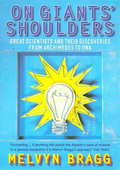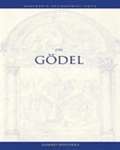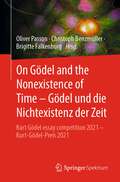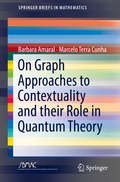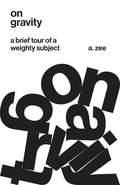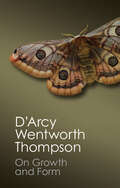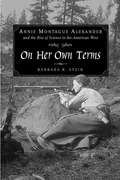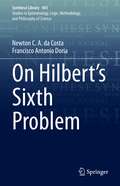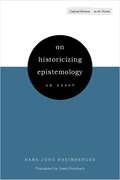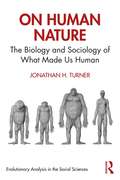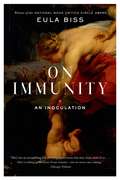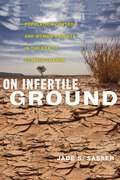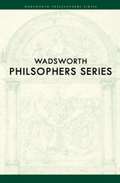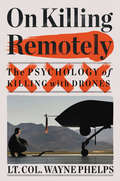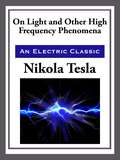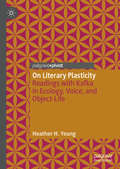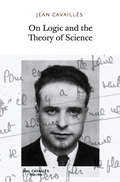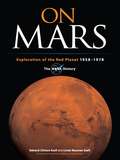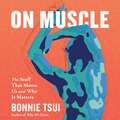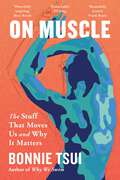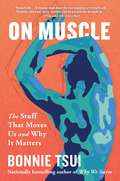- Table View
- List View
On Giants' Shoulders: Great Scientists and Their Discoveries from Archimedes to DNA
by Melvyn BraggThe fascinating story of science unfolds in this account of the lives and extraordinary discoveries of twelve of its greatest figures - Archimedes, Galileo, Newton, Lavoisier, Faraday, Darwin, Poincaré, Freud, Einstein, Marie Curie and Crick and Watson. Exploring their impact and legacy with leading scientists of today including Stephen Jay Gould, Oliver Sacks, Lewis Wolpert, Susan Greenfield, Roger Penrose and Richard Dawkins, Melvyn Bragg illuminates the core issues of science past and present, and conveys the excitement and importance of the scientific quest.
On Giants' Shoulders: Great Scientists and Their Discoveries from Archimedes to DNA
by Melvyn BraggThe fascinating story of science unfolds in this account of the lives and extraordinary discoveries of twelve of its greatest figures - Archimedes, Galileo, Newton, Lavoisier, Faraday, Darwin, Poincaré, Freud, Einstein, Marie Curie and Crick and Watson. Exploring their impact and legacy with leading scientists of today including Stephen Jay Gould, Oliver Sacks, Lewis Wolpert, Susan Greenfield, Roger Penrose and Richard Dawkins, Melvyn Bragg illuminates the core issues of science past and present, and conveys the excitement and importance of the scientific quest.
On Giving Up
by null Adam PhillipsOne of The New York Times Critics' Picks of the YearFrom acclaimed psychoanalyst Adam Phillips, a meditation on what we must give up to feel more alive.To give up or not to give up?The question can feel inescapable but the answer is never simple.Giving up our supposed vices is one thing; giving up on life itself is quite another. One form of self-sacrifice feels positive, something to admire and aspire to, while the other is profoundly unsettling, if not actively undesirable.There are always, it turns out, both good and bad sacrifices, but it is not always clear beforehand which is which. We give something up because we believe we can no longer go on as we are. In this sense, giving up is a critical moment—an attempt to make a different future.In On Giving Up, the acclaimed psychoanalyst Adam Phillips illuminates both the gaps and the connections between the many ways of giving up and helps us to address the central question: What must we give up in order to feel more alive?
On Gödel
by Jaakko HintikkaThis brief text assists students in understanding Godel's philosophy and thinking so that they can more fully engage in useful, intelligent class dialogue and improve their understanding of course content. Part of the "Wadsworth Philosophers Series," (which will eventually consist of approximately 100 titles, each focusing on a single "thinker" from ancient times to the present), ON G#65533;DEL is written by a philosopher deeply versed in the philosophy of this key thinker. Like other books in the series, this concise book offers sufficient insight into the thinking of a notable philosopher better enabling students to engage in the reading and to discuss the material in class and on paper.
On Gödel and the Nonexistence of Time – Gödel und die Nichtexistenz der Zeit: Kurt Gödel essay competition 2021 – Kurt-Gödel-Preis 2021
by Oliver Passon Christoph Benzmüller Brigitte FalkenburgKurt Gödel was not just a brilliant logician but contributed also important results to the general theory of relativity. In the 1940s he found a solution to Einstein's field equations which (roughly speaking) allows for time-travel, i.e. compromises our very notion of time. This book brings together the contributions to the Kurt Gödel essay competition on the question: "What does it mean for our world view if, according to Gödel, we also assume the non-existence of time?” Kurt Gödel war nicht nur ein brillanter Logiker, sondern trug auch wichtige Ergebnisse zur allgemeinen Relativitätstheorie bei. In den 1940er Jahren fand er eine Lösung für die Einsteinschen Feldgleichungen, die (grob gesagt) Zeitreisen ermöglicht, d.h. unsere Vorstellung von Zeit in Frage stellt. Dieses Buch versammelt die Beiträge zum Kurt-Gödel-Aufsatzwettbewerb zu der Frage: "Was bedeutet es für unser Weltbild, wenn wir mit Gödel die Nichtexistenz der Zeit annehmen?"
On Graph Approaches to Contextuality and their Role in Quantum Theory (SpringerBriefs in Mathematics)
by Barbara Amaral Marcelo Terra CunhaThis book explores two of the most striking features of quantum theory – contextuality and nonlocality – using a formulation based on graph theory. Quantum theory provides a set of rules to predict probabilities of different outcomes in different experimental settings, and both contextuality and nonlocality play a fundamental role in interpreting the outcomes. In this work, the authors highlight how the graph approach can lead to a better understanding of this theory and its applications. After presenting basic definitions and explaining the non-contextuality hypothesis, the book describes contextuality scenarios using compatibility hypergraphs. It then introduces the exclusivity graph approach, which relates a number of important graph-theoretical concepts to contextuality. It also presents open problems such as the so-called Exclusivity Principle, as well as a selection of important topics, like sheaf-theoretical approach, hypergraph approach, and alternative proofs of contextuality.
On Gravity: A Brief Tour of a Weighty Subject
by A. ZeeA brief introduction to gravity through Einstein’s general theory of relativityOf the four fundamental forces of nature, gravity might be the least understood and yet the one with which we are most intimate. From the months each of us spent suspended in the womb anticipating birth to the moments when we wait for sleep to transport us to other realities, we are always aware of gravity. In On Gravity, physicist A. Zee combines profound depth with incisive accessibility to take us on an original and compelling tour of Einstein's general theory of relativity. Inspired by Einstein's audacious suggestion that spacetime could ripple, Zee begins with the stunning discovery of gravity waves. He goes on to explain how gravity can be understood in comparison to other classical field theories, presents the idea of curved spacetime and the action principle, and explores cutting-edge topics, including black holes and Hawking radiation. Zee travels as far as the theory reaches, leaving us with tantalizing hints of the utterly unknown, from the intransigence of quantum gravity to the mysteries of dark matter and energy.Concise and precise, and infused with Zee's signature warmth and freshness of style, On Gravity opens a unique pathway to comprehending relativity and gaining deep insight into gravity, spacetime, and the workings of the universe.
On Growth and Form
by D'Arcy Wentworth ThompsonSir D'Arcy W. Thompson CB FRS FRSE (1860-1948) was a Scottish biologist, mathematician, and classics scholar. A pioneering mathematical biologist, he is mainly remembered as the author of ON GROWTH AND FORM, an influential work of striking originality and elegance. The central theme of ON GROWTH AND FORM is that biologists of its author's day overemphasized evolution as the fundamental determinant of the form and structure of living organisms, and under-emphasized the roles of physical laws and mechanics. Peter Medawar who was the 1960 Nobel Laureate in Medicine called ON GROWTH AND FORM "the finest work of literature in all the annals of science that have been recorded in the English tongue."
On Her Own Terms: Annie Montague Alexander and the Rise of Science in the American West
by Barbara R. SteinThe biography of Annie Alexander (1867-1950), an adventurous, independent woman, amateur naturalist, intrepid collector of mammals and fossils, she was the founder and patron of two natural history museums at the UC, Berkeley, and remains an inspiration to all women, especially those in science.
On Hilbert's Sixth Problem (Synthese Library #441)
by Newton C. da Costa Francisco Antonio DoriaThis book explores the premise that a physical theory is an interpretation of the analytico–canonical formalism. Throughout the text, the investigation stresses that classical mechanics in its Lagrangian formulation is the formal backbone of theoretical physics. The authors start from a presentation of the analytico–canonical formalism for classical mechanics, and its applications in electromagnetism, Schrödinger's quantum mechanics, and field theories such as general relativity and gauge field theories, up to the Higgs mechanism.The analysis uses the main criterion used by physicists for a theory: to formulate a physical theory we write down a Lagrangian for it. A physical theory is a particular instance of the Lagrangian functional. So, there is already an unified physical theory. One only has to specify the corresponding Lagrangian (or Lagrangian density); the dynamical equations are the associated Euler–Lagrange equations. The theory of Suppes predicates as the main tool in the axiomatization and examples from the usual theories in physics. For applications, a whole plethora of results from logic that lead to interesting, and sometimes unexpected, consequences.This volume looks at where our physics happen and which mathematical universe we require for the description of our concrete physical events. It also explores if we use the constructive universe or if we need set–theoretically generic spacetimes.
On Historicizing Epistemology: An Essay (Cultural Memory in the Present)
by Hans-Jörg RheinbergerEpistemology, as generally understood by philosophers of science, is rather remote from the history of science and from historical concerns in general. Rheinberger shows that, from the late nineteenth through the late twentieth century, a parallel, alternative discourse sought to come to terms with the rather fundamental experience of the thoroughgoing scientific changes brought on by the revolution in physics. Philosophers of science and historians of science alike contributed their share to what this essay describes as an ongoing quest to historicize epistemology. Historical epistemology, in this sense, is not so concerned with the knowing subject and its mental capacities. Rather, it envisages science as an ongoing cultural endeavor and tries to assess the conditions under which the sciences in all their diversity take shape and change over time.
On Human Nature: The Biology and Sociology of What Made Us Human (Evolutionary Analysis in the Social Sciences)
by Jonathan H. TurnerIn this book, Jonathan H. Turner combines sociology, evolutionary biology, cladistic analysis from biology, and comparative neuroanatomy to examine human nature as inherited from common ancestors shared by humans and present-day great apes. Selection pressures altered this inherited legacy for the ancestors of humans—termed hominins for being bipedal—and forced greater organization than extant great apes when the hominins moved into open-country terrestrial habitats. The effects of these selection pressures increased hominin ancestors’ emotional capacities through greater social and group orientation. This shift, in turn, enabled further selection for a larger brain, articulated speech, and culture along the human line. Turner elaborates human nature as a series of overlapping complexes that are the outcome of the inherited legacy of great apes being fed through the transforming effects of a larger brain, speech, and culture. These complexes, he shows, can be understood as the cognitive complex, the psychological complex, the emotions complex, the interaction complex, and the community complex.
On Immunity: An Inoculation
by Eula BissOne of New York Times Best 10 Books of 2014. <P><P> Why do we fear vaccines? A provocative examination by Eula Biss, the author of Notes from No Man's Land, winner of the National Book Critics Circle Award<P> Upon becoming a new mother, Eula Biss addresses a chronic condition of fear--fear of the government, the medical establishment, and what is in your child's air, food, mattress, medicine, and vaccines. She finds that you cannot immunize your child, or yourself, from the world.<P> In this bold, fascinating book, Biss investigates the metaphors and myths surrounding our conception of immunity and its implications for the individual and the social body. As she hears more and more fears about vaccines, Biss researches what they mean for her own child, her immediate community, America, and the world, both historically and in the present moment. She extends a conversation with other mothers to meditations on Voltaire's Candide, Bram Stoker's Dracula, Rachel Carson's Silent Spring, Susan Sontag's AIDS and Its Metaphors, and beyond. On Immunity is a moving account of how we are all interconnected--our bodies and our fates.<P> Chosen for Mark Zuckerberg's "A Year of Books"
On Infertile Ground: Population Control and Women's Rights in the Era of Climate Change
by Jade S. SasserA critique of population control narratives reproduced by international development actors in the 21st century Since the turn of the millennium, American media, scientists, and environmental activists have insisted that the global population crisis is “back”—and that the only way to avoid catastrophic climate change is to ensure women’s universal access to contraception. Did the population problem ever disappear? What is bringing it back—and why now? In On Infertile Ground, Jade S. Sasser explores how a small network of international development actors, including private donors, NGO program managers, scientists, and youth advocates, is bringing population back to the center of public environmental debate. While these narratives never disappeared, Sasser argues, histories of human rights abuses, racism, and a conservative backlash against abortion in the 1980s drove them underground—until now. Using interviews and case studies from a wide range of sites—from Silicon Valley foundation headquarters to youth advocacy trainings, the halls of Congress and an international climate change conference—Sasser demonstrates how population growth has been reframed as an urgent source of climate crisis and a unique opportunity to support women’s sexual and reproductive health and rights. Although well-intentioned—promoting positive action, women’s empowerment, and moral accountability to a global community—these groups also perpetuate the same myths about the sexuality and lack of virtue and control of women and the people of global south that have been debunked for decades. Unless the development community recognizes the pervasive repackaging of failed narratives, Sasser argues, true change and development progress will not be possible. On Infertile Ground presents a unique critique of international development that blends the study of feminism, environmentalism, and activism in a groundbreaking way. It will make any development professional take a second look at the ideals driving their work.
On Intelligence: How a New Understanding of the Brain Will Lead to the Creation of Truly Intelligent Machines
by Jeff Hawkins Sandra BlakesleeThe inventor of the PalmPilot shares a compelling new theory of intelligence, brain function, and the future of artificial intelligence.Tech innovator Jeff Hawkins reshaped our relationship to computers with devices like the PalmPilot. Now he stands ready to revolutionize both neuroscience and computing in one stroke, with a new understanding of intelligence itself. In this book, Hawkins develops a powerful theory of human cognition and explains how, based on his theory, we can finally build intelligent machines.According to Hawkins, the brain is a complex system that remembers sequences of events and their nested relationships. This style of organization reflects the true structure of the world and allows us to make increasingly accurate predictions. This memory-prediction process in turn forms the basis of intelligence, perception, creativity, and even consciousness.In an engaging style accessible to the general reader, Hawkins shows how a clear understanding of brain function can be applied to building intelligent machines, in silicon, that will exceed our human ability in surprising ways. Written with acclaimed science writer Sandra Blakeslee, On Intelligence is a landmark book in its scope and clarity.“Brilliant and imbued with startling clarity . . . the most important book in neuroscience, psychology, and artificial intelligence in a generation.” —Malcolm Young, University of Newcastle
On Jung
by Richard BilskerTHE WADSWORTH PHILOSOPHERS SERIES is dedicated to providing both philosophy students and general readers with insight into the background, development, and thinking of great intellects throughout the history of civilization. More than a simple guide, each of the volumes has the goal of helping to empower the reader when analyzing and discussing original works.
On Killing Remotely: The Psychology of Killing with Drones
by Lieutenant Colon Wayne PhelpsA &“can&’t-miss for anyone interested in current military affairs,&” On Killing Remotely reveals and explores the costs—to individual soldiers and to society—of the way we wage war today (Kirkus Reviews, starred). Throughout history society has determined specific rules of engagement between adversaries in armed conflict. With advances in technology, from armor to in the Middle Ages to nerve gas in World War I to weapons of mass destruction in our own time, the rules have constantly evolved. Today, when killing the enemy can seem palpably risk-free and tantamount to playing a violent video game, what constitutes warfare? What is the effect of remote combat on individual soldiers? And what are the unforeseen repercussions that could affect us all? Lt Col Wayne Phelps, former commander of a Remotely Piloted Aircraft unit, addresses these questions and many others as he tells the story of the men and women of today&’s &“chair force.&” Exploring the ethics of remote military engagement, the misconceptions about PTSD among RPA operators, and the specter of military weaponry controlled by robots, his book is an urgent and compelling reminder that it should always be difficult to kill another human being lest we risk losing what makes us human.
On Knowing--The Natural Sciences (Historical Studies Of Urban America Ser.)
by Richard P. McKeon David B. Owen Zahava K. McKeonWell before the current age of discourse, deconstruction, and multiculturalism, Richard McKeon propounded a philosophy of pluralism showing how "facts" and "values" are dependent on diverse ways of reading texts. This book is a transcription of an entire course, including both lectures and student discussions, taught by McKeon. As such, it provides an exciting introduction to McKeon's conception of pluralism, a central aspect of neo-Pragmatism, while demonstrating how pluralism works in a classroom setting. In his lectures, McKeon outlines the entire history of Western thinking on the sciences. Treating the central concepts of motion, space, time, and cause, he traces modern intellectual debates back to the ancient Greeks, notably Plato, Aristotle, Democritus, and the Sophists. As he brings the story of Western science up to the twentieth century, he uses his fabled semantic schema (reproduced here for the first time) to uncover new ideas and observations about cosmology, mechanics, dynamics, and other aspects of physical science. Illustrating the broad historical sweep of the lectures are a series of discussions which give detail to the course's intellectual framework. These discussions of Plato, Aristotle, Galileo, Newton, and Maxwell are perhaps the first published rendition of a philosopher in literal dialogue with his students. Led by McKeon's pointed questioning, the discussions reveal the difficulties and possibilities of learning to engage in serious intellectual communication.
On Light and Other High Frequency
by Nikola TeslaA lecture delivered before the Franklin Institute, Philadelphia, February 1893, and before the National Electric Light Association, St. Louis, March 1893.
On Literary Plasticity: Readings with Kafka in Ecology, Voice, and Object-Life
by Heather H. YeungOn Literary Plasticity: Readings with Kafka in Ecology, Voice, and Object-Life calls to Franz Kafka, and in particular ‘Die Sorge des Hausvaters’, for aid in charting the long reach of plastic on the human mind and world. In this book, Heather H. Yeung builds a past and future ecology of plastic, arguing that it is through a deep reading of literature that we can begin to understand more clearly what it is that plastic means to us today, asking, under the auspices of the idea of literary plasticity: what are the true depths of our twenty-first-century fascination with plastic? How did we become so entangled? How can we come to a better understanding of plastic’s role in our imagination, our environment, and our lives? What can literature teach us in this respect? Why should we care?
On Logic and the Theory of Science
by Jean CavaillesA new translation of the final work of French philosopher Jean Cavaillès.In this short, dense essay, Jean Cavaillès evaluates philosophical efforts to determine the origin—logical or ontological—of scientific thought, arguing that, rather than seeking to found science in original intentional acts, a priori meanings, or foundational logical relations, any adequate theory must involve a history of the concept.Cavaillès insists on a historical epistemology that is conceptual rather than phenomenological, and a logic that is dialectical rather than transcendental. His famous call (cited by Foucault) to abandon "a philosophy of consciousness" for "a philosophy of the concept" was crucial in displacing the focus of philosophical enquiry from aprioristic foundations toward structural historical shifts in the conceptual fabric.This new translation of Cavaillès's final work, written in 1942 during his imprisonment for Resistance activities, presents an opportunity to reencounter an original and lucid thinker. Cavaillès's subtle adjudication between positivistic claims that science has no need of philosophy, and philosophers' obstinate disregard for actual scientific events, speaks to a dilemma that remains pertinent for us today. His affirmation of the authority of scientific thinking combined with his commitment to conceptual creation yields a radical defense of the freedom of thought and the possibility of the new.
On Mars: Exploration of the Red Planet, 1958-1978--The NASA History (Dover Books on Astronomy)
by Paul Dickson Edward Clinton Ezell Linda Neuman EzellAlthough it was only designed for a ninety-day surface mission, the Viking 1 lander ultimately transmitted science messages to Earth for seven years. This authoritative history chronicles the remarkable achievements of the Viking program during its first three decades. Commissioned by NASA, it recounts the events surrounding the first planetary landing on Earth's closest neighbor and the first on-site search for evidence of extraterrestrial life. It also portrays a human drama in which thousands of professionals from government, industry, and academia joined together to accomplish the seemingly impossible.This history begins with a survey of the qualities that make the surface and atmosphere of Mars prime targets for scientific investigation. A retrospective of NASA's Mariner program follows, detailing the series of robotic interplanetary probes that led to the initiation of the Viking program in 1968. The authors trace the ensuing technological developments, including the first lander vehicles and orbiter. They also profile the cooperation of managerial, technical, and scientific teams during the mission's data-gathering and analysis phases. The final chapters outline the scientific results of the Viking investigations, examine some of the unresolved questions, and consider possible future explorations. Dozens of photos taken by Viking cameras illuminate the text.
On Muscle: The Stuff That Moves Us and Why It Matters
by Bonnie Tsui'Remarkable . . . A singular book about the true meanings of strength and flexibility, about our ability to define who we are and who we might be' Ed Yong, New York Times bestselling author of An Immense World and I Contain MultitudesFrom the bestselling author of Why We Swim comes a mind-expanding exploration of muscle that will change the way you think about how we move and why it matters.Cardiac, smooth, skeletal-these three different types of muscle in our bodies make our hearts beat; push food through our intestines, blood through our vessels, attach to our bones and help us move. Individually, they do different things. Collectively, they drive us through our days.Join athlete and writer Bonnie Tsui as she jumps headfirst into the intriguing world of muscle from the five angles of strength, form, action, flexibility and endurance. Tsui introduces us to the first female weightlifter to pick up the famed Scottish Dinnie Stones, then takes us on a 50-mile run through the Nevada desert that follows the path of escape from a Native boarding school, giving the concept of endurance new meaning. She travels to Oslo, where cutting-edge research reveals how muscles help us bounce back after injury and illness, an important aspect of longevity. She jumps into the action with a historic Double Dutch club in Washington, D.C., to explain anew what Charles Darwin meant by the brain-body connection.On Muscle is a powerful reminder that using our muscles promote longevity, joy, and, most important, the feeling that we can do anything.
On Muscle: The Stuff That Moves Us and Why It Matters
by Bonnie Tsui'Remarkable . . . A singular book about the true meanings of strength and flexibility, about our ability to define who we are and who we might be' Ed Yong, New York Times bestselling author of An Immense World and I Contain MultitudesFrom the bestselling author of Why We Swim comes a mind-expanding exploration of muscle that will change the way you think about how we move and why it matters.Cardiac, smooth, skeletal-these three different types of muscle in our bodies make our hearts beat; push food through our intestines, blood through our vessels, attach to our bones and help us move. Individually, they do different things. Collectively, they drive us through our days.Join athlete and writer Bonnie Tsui as she jumps headfirst into the intriguing world of muscle from the five angles of strength, form, action, flexibility and endurance. Tsui introduces us to the first female weightlifter to pick up the famed Scottish Dinnie Stones, then takes us on a 50-mile run through the Nevada desert that follows the path of escape from a Native boarding school, giving the concept of endurance new meaning. She travels to Oslo, where cutting-edge research reveals how muscles help us bounce back after injury and illness, an important aspect of longevity. She jumps into the action with a historic Double Dutch club in Washington, D.C., to explain anew what Charles Darwin meant by the brain-body connection.On Muscle is a powerful reminder that using our muscles promote longevity, joy, and, most important, the feeling that we can do anything.
On Muscle: The Stuff That Moves Us and Why It Matters
by Bonnie TsuiFrom the bestselling author of Why We Swim comes a mind-expanding exploration of muscle that will change the way you think about what moves us through the world. &“Remarkable . . . A singular book about the true meanings of strength and flexibility, about our ability to define who we are and who we might be.&” —Ed Yong, New York Times bestselling author of An Immense World and I Contain Multitudes In On Muscle, Bonnie Tsui brings her signature blend of science, culture, immersive reporting, and personal narrative to examine not just what muscles are but what they mean to us. Cardiac, smooth, skeletal—these three different types of muscle in our bodies make our hearts beat; push food through our intestines, blood through our vessels, babies out the uterus; attach to our bones and allow for motion. Tsui also traces how muscles have defined beauty—and how they have distorted it—through the ages, and how they play an essential role in our physical and mental health. Tsui introduces us to the first female weightlifter to pick up the famed Scottish Dinnie Stones, then takes us on a 50-mile run through the Nevada desert that follows the path of escape from a Native boarding school—and gives the concept of endurance new meaning. She travels to Oslo, where cutting-edge research reveals how muscles help us bounce back after injury and illness, an important aspect of longevity. She jumps into the action with a historic Double Dutch club in Washington, D.C., to explain anew what Charles Darwin meant by the brain-body connection. Woven throughout are stories of Tsui&’s childhood with her Chinese immigrant artist dad—a black belt in karate—who schools her from a young age in a kind of quirky, in-house Muscle Academy. On Muscle shows us the poetry in the physical, and the surprising ways muscle can reveal what we&’re capable of.
